If you’re planning hikes in Organ Pipe Cactus National Monument, you’ll want a clear sense of which trails match your skills and interests. I’ll point out the best loops and day hikes, note difficulty and distance, and flag seasonal concerns and safety essentials so you can pick routes confidently — and avoid common mistakes that spoil trips.
Top Trails to Hike in Organ Pipe Cactus National Monument
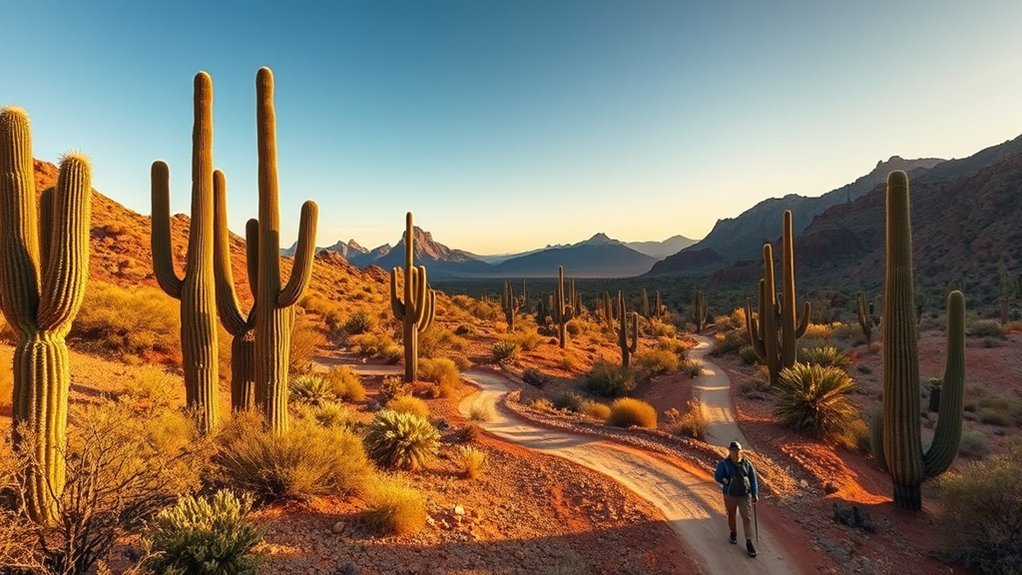
While the monument’s landscape looks remote, you’ll find a range of well-marked trails that suit short nature walks and longer desert scrambles alike; you can pick routes that match time and interest. You’ll reach historic remains on the Victoria Mine Trail, a classic desert hike that rewards effort with mining ruins. If you want sweeping panoramas, choose the Bull Pasture Trail for rugged vistas. For quick scenic loops and birdwatching, the Desert View Trail and Alamo Canyon Trail both deliver short, wildlife-rich experiences. When you’re after a distinctive geological feature, the Arch Canyon Trail leads to the Arch and offers sustained views. Each trail’s length and expected duration help you plan efficient outings without surprises.
Trail Details and Difficulty Ratings
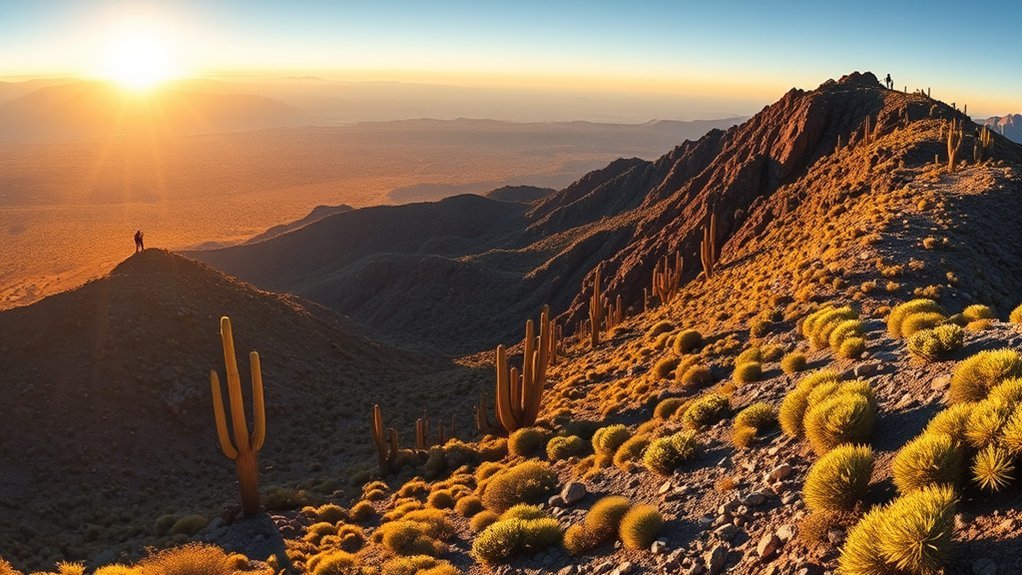
You’ll want to compare trail lengths and estimated times so you can match hikes to your schedule and fitness. Pay close attention to elevation gain and rated difficulty — a 10.6-mile loop with 2,634 feet of gain is a different commitment than a 1.1-mile birding stroll. Also note terrain and access—rocky, exposed routes demand sturdier gear and stronger footing than short, well-maintained paths.
Trail Lengths & Times
Because trail length and expected time determine how you plan your day and pack water, pay close attention to distance, elevation, and typical completion times when choosing hikes at Organ Pipe Cactus National Monument. On the desert floor, shorter outings like the 1.1-mile Desert View loop take about 30–60 minutes and suit quick birdwatching. The Bull Pasture Trail covers 2.5 miles and usually takes 1–1.5 hours, offering swift vistas. Arch Canyon runs 2.9 miles and requires roughly 2–2.5 hours to reach the Arch. Victoria Mine is 4.4 miles, a classic 1.5–2 hour desert-floor trek to an old silver mine. Longer backcountry options include the 10.6-mile Kino Pass to Kino Peak; plan accordingly for sustained hiking duration.
Elevation & Difficulty
After checking trail lengths and times, you’ll want to match routes to the elevation and difficulty profiles to plan effort and water needs. Organ Pipe trails range from minimal elevation gain to sustained climbs, so pick according to fitness and conditions. Easy trails like Desert View gain about 100 feet — great for families. Victoria Mine is a moderate hike with roughly 500 feet of ascent and classic desert scenery. For experienced hikers, Mount Ajo via Bull Pasture to Estes Canyon is a strenuous hike with 2,634 feet of climbing; prepare accordingly.
- Choose easy trails for short outings and low water needs.
- Opt for the Victoria Mine moderate hike for scenic reward with moderate effort.
- Reserve Mount Ajo for fit hikers ready for sustained elevation gain.
Terrain & Accessibility
When planning hikes in Organ Pipe Cactus National Monument, match trail terrain and access to your skill level and gear: the park maintains 19 trails with difficulty ratings from easy to hard, so you can pick short, family-friendly paths like the 1.1‑mile Desert View or tackle strenuous routes such as Mount Ajo with its 2,634 feet of gain. You’ll find desert singletrack, rocky switchbacks, and moderate service roads; Kino Pass to Kino Peak and Bates Mountains extends 10.6 miles for experienced hikers seeking a full day. Bull Pasture (2.5 miles) and Victoria Mine (4.4 miles) offer scenic, historically rich outings within a couple hours. Check trailhead access, elevation gain, surface conditions, and seasonal closures to guarantee safe, suitable hiking and accessibility.
Longest and Most Challenging Routes
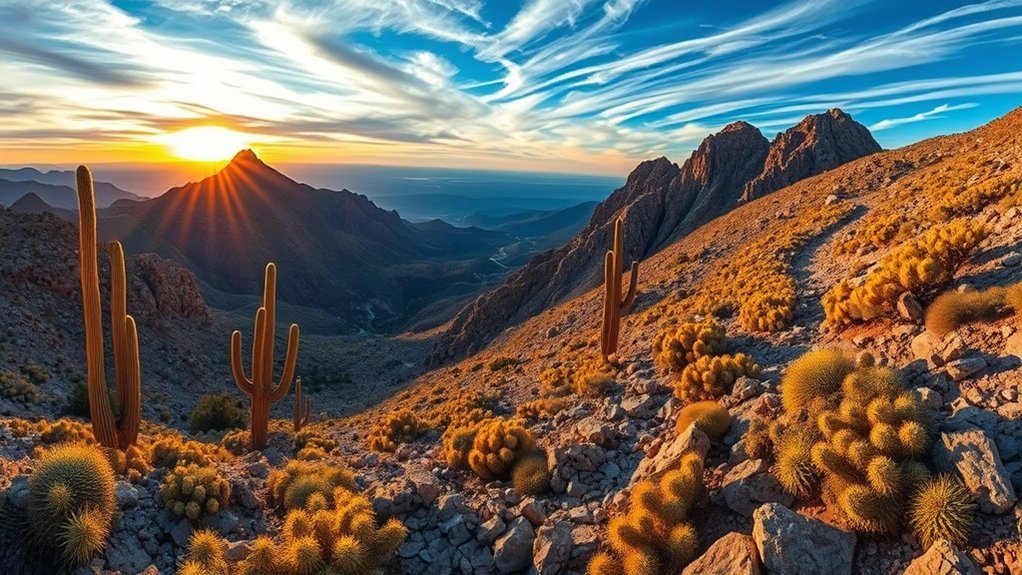
Start with the Kino Pass route if you want the longest single trek — the Kino Pass to Kino Peak and Bates Mountains stretches about 10.6 miles. If you’re after the toughest ascent, tackle Mount Ajo via Bull Pasture to Estes Canyon Loop, which climbs roughly 2,634 feet. For a rugged loop that offers varied terrain and access to multiple side trails, explore the Ajo Mountain Loop.
Kino Pass Route
- You’ll tackle the Kino Pass trail — a 10.6-mile route to Kino Peak and the Bates Mountains that demands respect. With 2,634 feet of elevation gain, this is the monument’s most strenuous outing and suits only experienced hikers. You’ll face long distance, steep inclines, and desert exposure, so prepare physically and mentally.
- Carry ample water and navigation tools.
- Start early, monitor weather, and pace yourself.
- Wear sturdy boots and sun protection.
You’ll be rewarded with stunning views and panoramic desert vistas from the summit, but don’t underestimate logistics: permit rules, emergency plans, and daylight limits matter. If you follow safety precautions and respect the terrain, the Kino Pass experience is uniquely rewarding.
Mount Ajo Ascent
After tackling the Kino Pass, you can push farther with the Mount Ajo ascent via the Bull Pasture–Estes Canyon Loop, the monument’s longest and most demanding route. You’ll face a 10.6-mile trail in Organ Pipe that delivers 2,634 feet of elevation gain; that steep, rugged profile tests endurance and route-finding skills. Start early to beat the heat, carry plenty of water, and plan for slow, steady progress on exposed slopes. The panoramic desert landscape rewards effort with sweeping views that validate the climb. Expect technical sections where footing is uneven and pace slows. If you’re fit, experienced, and prepared, Mount Ajo via Bull Pasture offers a singular, strenuous day-hike that showcases the monument’s best high-country scenery.
Ajo Mountain Loop
The Ajo Mountain Loop offers a long, varied outing—about 20.4 miles of scenic road and linked trails that can turn into a 7½–8 hour hike if you decide to explore on foot. You’ll follow Ajo Mountain Drive through Organ Pipe Cactus National, where the scenic drive doubles as access to multiple hiking trails and striking geology. Expect moderate elevation gain and sustained time on your feet; this is one of the park’s longest, most demanding routes. Plan for cooler months—December to March—when temperatures make the loop manageable. Pack water, navigation, and sun protection. Key considerations:
- Time commitment: full-day effort and route-finding skills.
- Terrain: mixed dirt road and singletrack hiking trails.
- Conditions: best in cooler months; check park alerts.
Scenic Drives and Biking Options
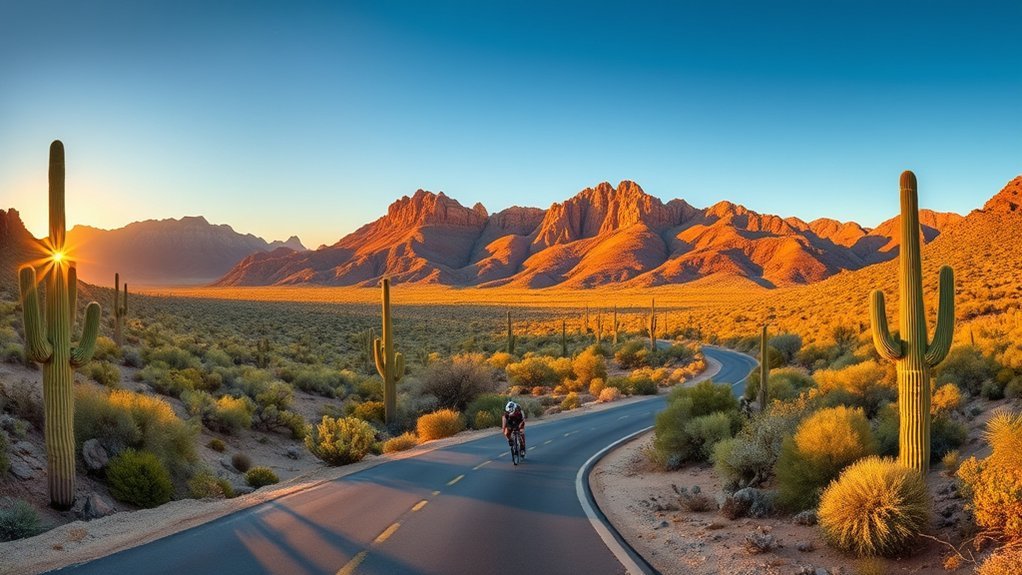
While you can explore Organ Pipe by foot, driving or cycling the park’s established routes lets you cover far more landscape in less time. You’ll find Ajo Mountain Drive at the visitor centre as the primary scenic drive: a one-way loop suitable for most vehicles and favored by cyclists for its accessibility and views. Puerto Blanco Drive stretches 41 miles into remote Sonoran Desert habitats, so plan carefully and expect rougher navigation. Both routes run year-round, with December–March offering the most comfortable temperatures. Two designated biking trails exist, but most riders choose Ajo Mountain Drive for combined convenience and scenery. Use these scenic drives for wildlife viewing and photography, and always carry water, maps, and communication gear.
Dripping Springs, Lost Cabin Mine, and Other Day Hikes
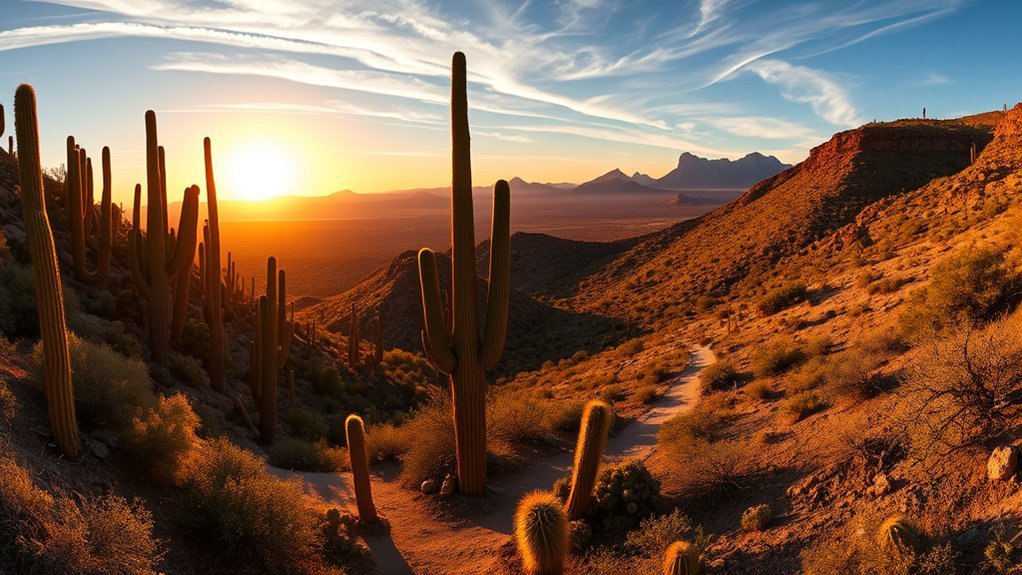
If you want varied day hikes that range from easy walks to full‑day outings, Organ Pipe delivers reliable options packed with history, desert scenery, and striking viewpoints. You can start at Dripping Springs, a mostly flat walk with short steep sections to a historic spring and views of the Valley of the Ajo. For a tougher outing, tackle the Lost Cabin Mine route—11.5 miles with climbs, the ghost‑camp remains, and a lunch stop overlooking Twin Peaks and Mount Ajo. Other solid day hikes include Victoria Mine and Bull Pasture, plus shorter routes that reveal cultural traces in Alamo Canyon.
Organ Pipe offers day hikes from easy Dripping Springs walks to all‑day Lost Cabin Mine adventures with desert history and big views
- Easy: Dripping Springs
- Moderate: Victoria Mine, Bull Pasture
- All‑day: Lost Cabin Mine
Alamo Canyon: History and Hiking Highlights
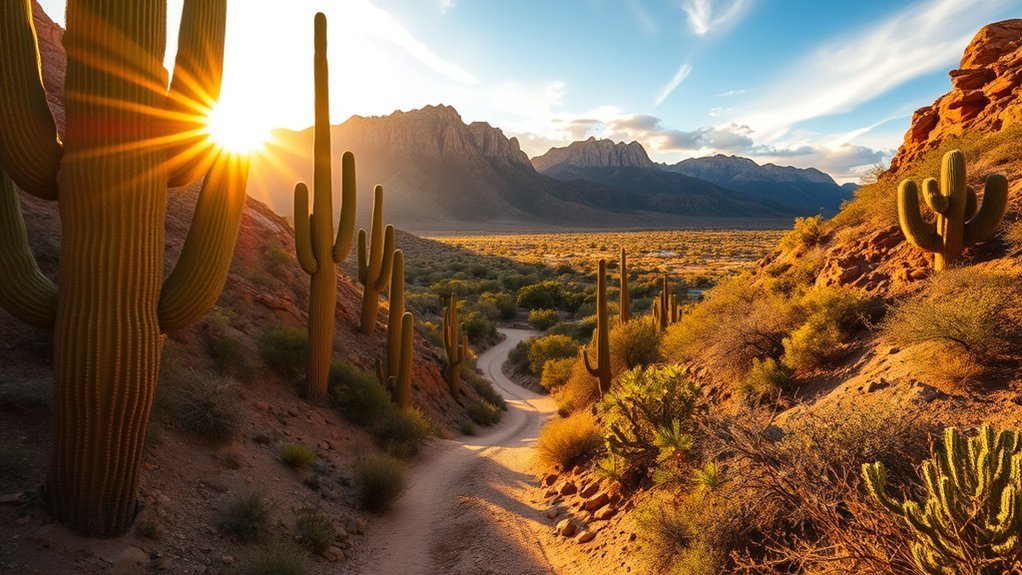
Because Alamo Canyon blends natural beauty with deep human history, you’ll find a short but rewarding 1.8‑mile out‑and‑back trail that ends at a partially hidden pool and passes volcanic obsidian and remnants of waterworks used by Tohono O’odham and early ranchers. You’ll hike well-maintained terrain rated 4.5 stars within Organ Pipe Cactus National Monument, where layers of use are visible in adobe remains and ranching artifacts tied to Birdie Miller’s tenure. The route emphasizes historical significance while offering varied desert scenery. You’ll also get excellent birdwatching opportunities—songbirds and raptors are common along washes and mesquite stands. Overall, Alamo Canyon delivers a compact, informative hike that rewards curiosity about human past and desert ecology without requiring a long trek.
Safety Tips and Essential Packing List
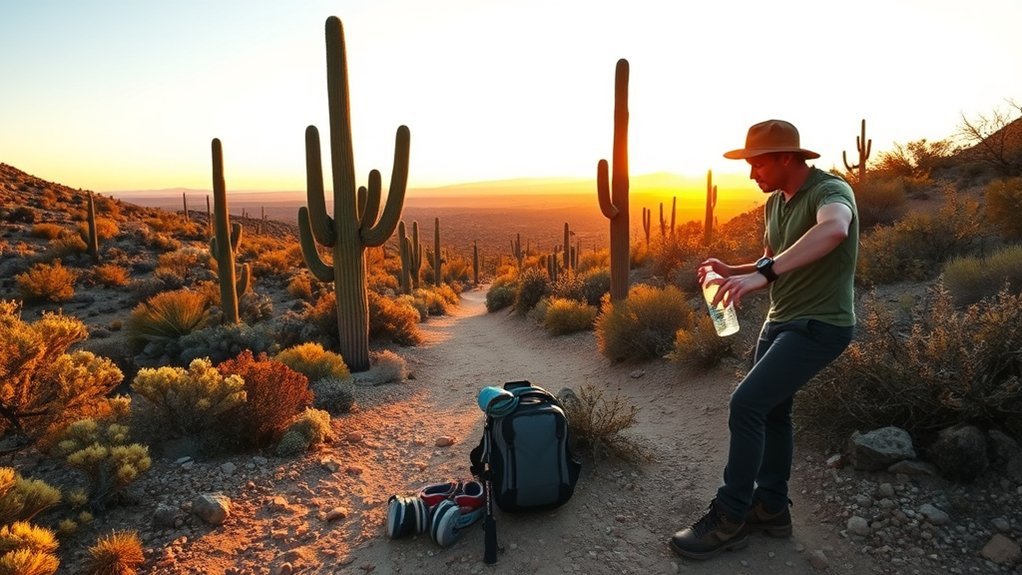
After exploring Alamo Canyon’s history and terrain, you’ll want to prepare carefully for the desert conditions before you go. Carry at least one gallon of water per person per day, apply sunscreen, and wear protective clothing and a hat. Always hike with a partner, tell someone your route and estimated return, and avoid washes during rain. Expect limited cell service; prioritize safety with a plan.
- Navigation: bring map and compass — many routes aren’t marked.
- Emergency kit: first aid, whistle, extra water, and shelter.
- Awareness: watch for bees near water and avoid midday heat.
Pack concisely, check conditions, and practice desert hiking skills to reduce risk and guarantee safety.
When to Visit and Seasonal Considerations
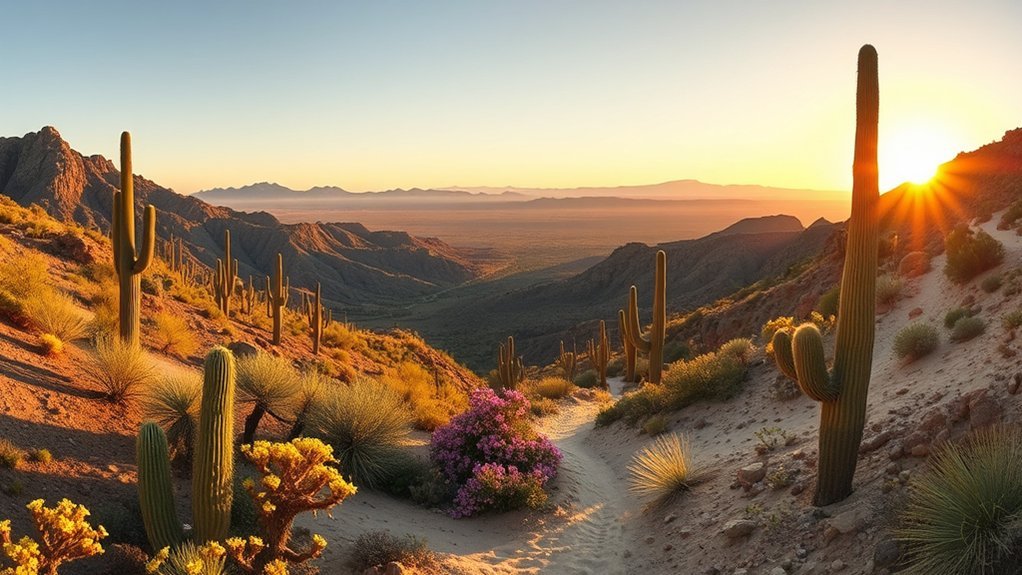
While you can hike here year-round, plan your trip between December and March for the mildest, most comfortable conditions; winter brings cooler days, spectacular desert sunsets and the Sonoran Desert’s blue hour, and January–February draw the most visitors if you want a livelier trail atmosphere. You’ll find December to March offer pleasant weather ideal for longer routes and early starts without extreme heat. If you prefer quieter trails, target November or shoulder days in the winter months for fewer crowds while still enjoying comfortable hiking. Avoid summer when temperatures commonly top 100°F — that’s risky and reduces trail options. Check forecasts, start hikes early, and adjust plans for seasonal wind or rare rain to keep outings safe and enjoyable.
Visitor Facilities, Permits, and Camping Information
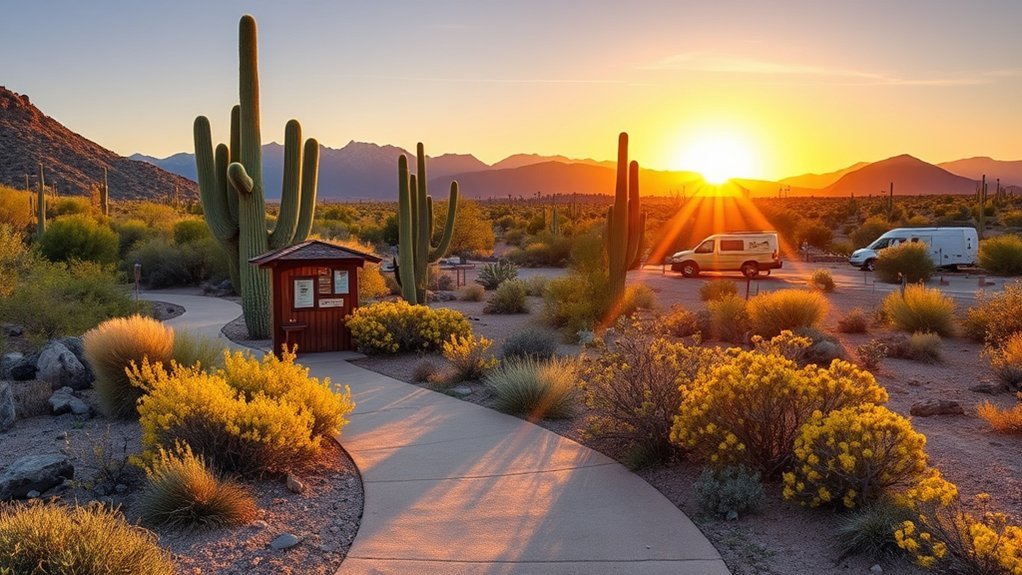
Plan your visit around the visitor center — it’s where you’ll pay the $25 per-vehicle entrance fee (or show an America the Beautiful annual pass), get up-to-date trail and safety information, and learn about campground rules and backcountry permits. The visitor facilities include restrooms at select trailheads, clear parking, and staffed desks to answer questions so you can plan hikes confidently. For overnight stays, follow campground rules and obtain required permits for backcountry travel.
Plan at the visitor center — pay the $25 entrance fee, get trail and safety updates, and secure permits.
- Reserve Twin Peaks Campground for RVs/tents; spaces fill early.
- Use Alamo Campground only for tents/small vans; it’s first-come, first-served with no water or fire.
- Acquire backcountry permits for one of four designated overnight zones before you go.
Frequently Asked Questions
What to Do at Organ Pipe Cactus National Monument?
You’ll explore wildlife viewing, enjoy desert photography, go star gazing, and learn cultural history on guided park ranger programs; hike varied trails, spot unique flora and fauna, and savor sunsets across rugged Sonoran landscapes.
What Is the Most Scenic Hike in Arizona?
You’ll likely pick the Grand Canyon’s Rim Trail as Arizona’s most scenic hike; I once watched light spill like molten gold there. Its scenic vistas, hiking trails, desert landscapes, photography spots, and wildlife viewing are unmatched.
Which Trail at Petroglyph National Monument Is Best?
Rinconada Canyon Trail is the best trail; you’ll see abundant petroglyphs history, scenic views, and family friendly hikes. Use hiking tips: bring water, wear sun protection, and respect rock art to preserve these cultural treasures.
How Long Does It Take to Walk Organ Pipes National Park?
You’ll need anywhere from 30 minutes to a full day: hiking duration depends on trail difficulty, with short loops 30–40 minutes and Kino Pass taking 6–8 hours; best times are morning, offering scenic views and wildlife sightings.
Conclusion
You’ve seen the best hikes here, so pack smart and get out there — remember, “fortune favors the bold.” Whether you’re tackling Kino Pass or strolling Desert View, choose routes that match your fitness and water supplies, tell someone your plan, and respect fragile desert life. Stay flexible with timing and weather, carry permits where required, and enjoy the Monument’s unique vistas responsibly. Go prepared, stay safe, and let the landscape reward your effort.

